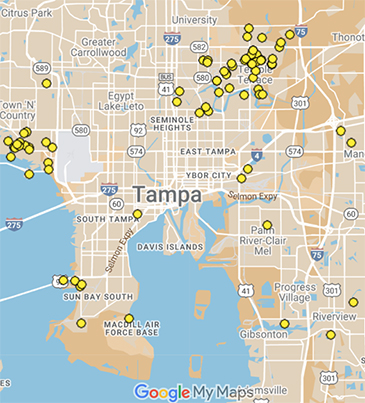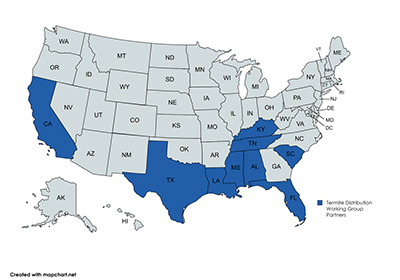Pest management professionals (PMPs) in the southern United States are well-acquainted with termites. Every day, PMPs protect their customers’ homes and businesses from infestations and battle termites that have already invaded a structure. If you ask a PMP where termite activity is highest, or if they have encountered Formosan subterranean termites, they typically respond immediately with no hesitation.
Historically, distributions of different termite species have been determined at the state-level by university researchers and extension services based on reports, submitted samples or active collection programs. This approach to determining and monitoring termite distribution is not always representative of their activity in an area and may be limited only to county-level reporting. These records are not typically compiled with neighboring states and evaluated over a larger area — remember, termites don’t read maps (although they would probably eat them)! Additionally, this style of distribution map may not distinguish between the termite species being established in the county versus a single collection from infested material, but may not be established (e.g., West Indian drywood termites in an infested piece of furniture). Some surveys may “color in” a county on the distribution map with a single collection, while others may require collections over multiple years to declare a county to have an established termite population.
The Formosan subterranean termite (Coptotermes formosanus) is an excellent example of an invasive termite species that can be encountered within the southern U.S. Outside of the University of Florida's Termite Distribution Map (discussed later in this article), there is little recent information on exactly where this termite species is found. Some state extension services in areas where Formosans are known to be maintain county-level maps or lists (e.g., Mississippi, Louisiana, Texas, South Carolina, etc., see Figure 1) but even these lack the needed details (GPS coordinates) and there are not active trapping programs underway to consistently update distribution maps as appropriate.

One of the primary issues with updating these maps is a lack of coordination and communication between those who encounter Formosans, and the individuals (primarily university/extension entomologists) that can confirm identification and track their activity on a large-scale. For example, a forestry researcher, a PMP, and a USDA scientists may all be working independently with Formosans; however, never communicate these findings to the entomologists that could update their recorded distribution and pass along these findings to appropriate stakeholders.
Recently, scientists with the University of Florida Institute of Food and Agricultural Sciences (UF/IFAS) have made a publicly available interactive termite distribution map for the state of Florida. Recognizing the importance of moving away from traditional county/parish-level distribution maps they instead plot the collection locations (adjusted slightly to respect privacy of homeowners with infested structures), thus giving a more accurate and current representation of distribution of a termite species. For example, a PMP, property owner, etc., can look at this map and instead of assuming that Formosans should be expected anywhere within a large county, they can pinpoint areas of higher reported activity (Figure 2). This of course doesn’t mean that Formosans do not exist where there is no reported collection data, only that scientists haven’t confirmed Formosan termites in those specific areas.

© credit | Surveying Termite Diversity in the Southern United States Working Group
A USDA Southern IPM Center grant was recently awarded to a working group consisting of 25 urban entomologists from universities, governmental agencies, and private industry, representing the states of: Texas, Louisiana, Mississippi, Alabama, Florida, South Carolina, Kentucky, Tennessee, and California, to better understand and track termite distribution in the Southern United States with a specific emphasis on the Formosan subterranean termite. The “Surveying Termite Diversity in the Southern United States Working Group” (SRTSWG) works collaboratively not only with each other, but also with PMPs within the region. This group’s goal is focused primarily on both actively trapping for Formosan alates (swarmers), but also to work with PMPs and other groups to encourage submission of samples to member institutions (primarily land grant university for each state respectively) to better understand where Formosans and other termites are in the region. The outputs will include open access online termite distribution maps and targeted termite training and identification keys for PMPs.
Formosan alate trapping will begin during the Spring of 2025. Simple glueboard-based trapping kits will be assembled and distributed amongst the working group and collaborators. Trapping locations will target areas adjacent to zones known to have Formosan activity or will be in areas deemed most likely and conducive to encounter Formosans. Traps will be deployed during known or suspected Formosan swarming season, which for most of the Southern U.S. is in late Spring. Collaborators will be instrumental in not only deploying traps but being entrusted to regularly monitor/replace glue boards and report findings. All glueboards with termite alates will be shipped back (prepaid shipping labels) to working group partners from each corresponding working group partner state where identification of any alates trapped will be confirmed.
In conjunction with the organized alate trapping, working group partners at institutions will immediately be receptive to any suspected Formosan termite samples from regions/counties not known historically to have activity. It is likely that PMPs from these various regions/states will be the major contributors of these samples as they already have the knowledge/skillset to identify various pests, and they are interacting with insect pests every day. To facilitate this, the working group plans to provide partners and collaborators with collection kits. It is important that PMPs in the southern U.S. forge strong bonds with extension/university entomologists in their state, but also to be aware of the current Formosan distribution within their state. There is a history of collaboration between the pest management industry and academia. Recently, this partnership has been exemplified by the thousands of termite samples that Florida PMPs have submitted to the University of Florida termite mapping program as well as PMPs in Southern California notifying UC Riverside of the reappearance of Formosans, as well as the presence of the Asian subterranean termite (Coptotermes gestroi) this year.
In addition to mapping, we will also offer trainings in termite identification through field days and workshops. Our focus will be on offering support in providing details of characteristic features of prominent termite species and their behavior enabling PMPs to achieve correct identification and better decisions.
If you work in any of the states listed previously (Figure 3) and are interested in participating as a collaborator by either setting alate traps and/or submitting samples, please communicate with your state’s Urban Entomologist for more information and sign up for the “Collaborators For Surveying Termite Diversity in the Southern United States Working Group” interest list.

If you are unsure who to reach out to, or have further questions, please email any of the following Co-Principal Investigators on this project: Dr. Aaron Ashbrook (Louisiana State University, aashbrook@agcenter.lsu.edu), Dr. Anamika Sharma (Florida A&M University, anamika.sharma@famu.edu) , or Dr. Santos Portugal, BCE (Mississippi State University, sportugal@entomology.msstate.edu).
This working group looks to provide PMPs, homeowners, the general public, and other stakeholders, an updated distribution map of the Formosan subterranean termite in the Southern United States. Pest management professionals will play a critical role in this project. We hope that projects such as this can continue to open lines of communication and establish future collaborative efforts with PMPs and urban entomologists.
The authors are Santos Portugal, department of biochemistry, molecular biology, entomology & plant pathology, Mississippi State University, Starkville, Miss.; Aaron Ashbrook, department of entomology, Louisiana State University, Baton Rouge, La.; and Anamika Sharma, center for biological control, college of agriculture and food sciences, Florida A&M University, Tallahassee, Fla.
Latest from Pest Control Technology
- Orkin Helps Local Youth Sports Program Design a ‘Killah’ New Logo
- ABC Home & Commercial Services Celebrates 75 Years in Business
- NPMA Academy Announces Full Schedule
- Truly Nolen Promotes Marchello, Christopherson and Bolton to Managerial Positions
- TruGreen Announces 2024 List of Top 20 U.S. Buggiest Cities
- Why PMPs Use Rodent Bait Stations
- NPMA’s Women’s Forum Encouraged Female Leadership, Growth Opportunities in Pest Control
- GoPest Expands to Birmingham and Huntsville (Ala.)





